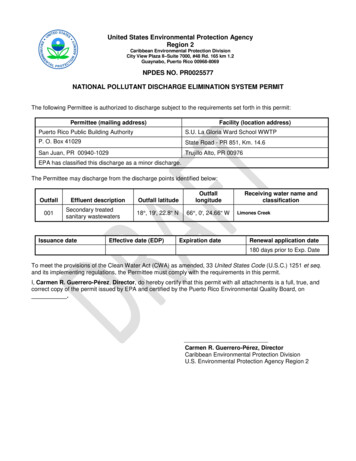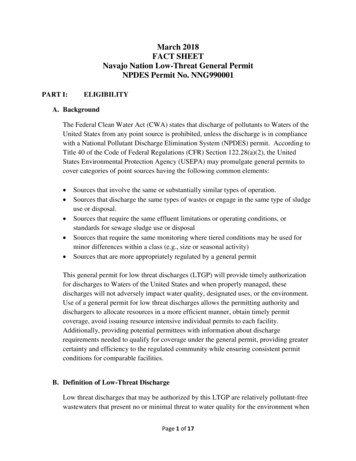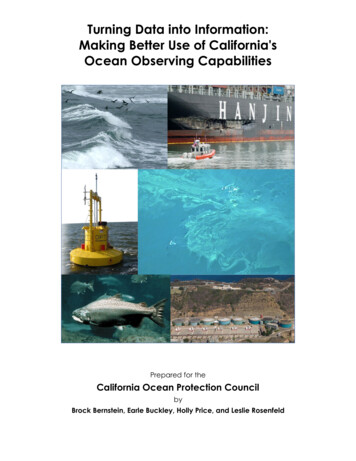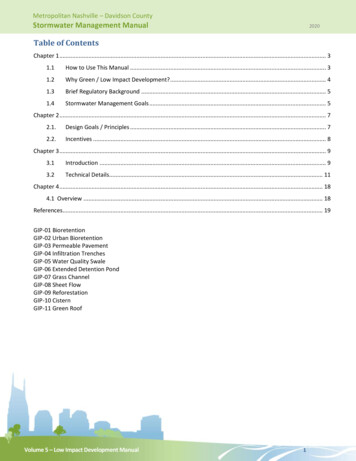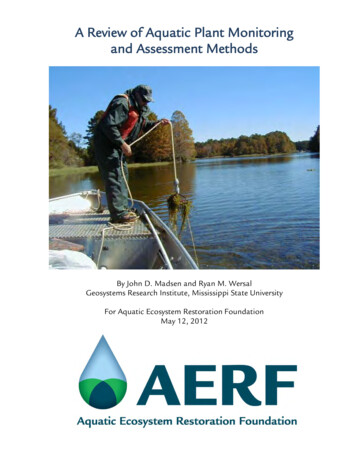
Transcription
Expiration Date: December 29, 2015Permit Number: 101513File Number: 108919NATIONAL POLLUTANT DISCHARGE ELIMINATION SYSTEMMUNICIPAL SEPARATE STORM SEWER SYSTEM (MS4) DISCHARGE PERMITOregon Department of Environmental Quality811 SW 6th AvenuePortland, OR 97204(503) 229-5185Issued pursuant to Oregon Revised Statute 468B.050 and the Federal Clean Water ActISSUED TO:City of SalemSOURCES COVERED BY THIS PERMIT:This permit covers all existing and new discharges ofstormwater from the Municipal Separate Storm SewerSystem (MS4) within the incorporated areas of the City ofSalem.COUNTY: Marion and PolkMAJOR RECEIVING WATERBODIES:Basin(s): Willamette RiverSubbasin(s): Middle Willamette, Molalla-PuddingWaterbodies: Willamette River; Little Pudding River;Claggett Creek; Pringle Creek; Battle Creek; Clark Creek;Croisan Creek; Gibson Gulch (Creek); Glenn Creek; LaurelCreek; Mill Creek; Pettijohn Creek; Shelton Ditch;Willamette SloughWASTE LOAD ALLOCATIONS: A Total MaximumDaily Load (TMDL) that includes waste load allocationsfor urban stormwater has been established for the MiddleWillamette and Molalla-Pudding Subbasins. Thesesubbasins include the Little Pudding watershed, Mill Creekwatershed, Pringle watershed, and the Willamette Rivertributaries. Waste load allocations are addressed inSchedule D of this permit.Annette iebe, Surface Water Management Section Manager
PERMITTED ACTIVITIESUntil this permit expires or is modified or revoked, the permittee is authorized to dischargemunicipal stormwater to waters of the state in conformance with the requirements and conditions setforth in the attached schedules. Where conflict exists between specific conditions (found inSchedules A-D) and general conditions (Schedule F), the specific conditions supersede the generalconditions.PageSchedule A . - Controls and Limitations 2Schedule B . - Monitoring and Repmting Requirements 14Schedule C . - Compliance Schedules 20ScheduleD . - Special Conditions 20Schedule F . - General Conditions 26SCHEDULE AControls and Limitations for Stormwater Discharges from Municipal Separate Storm SewerSystems1.Prohibit Non-stormwater DischargesThe permittee must effectively prohibit non-stormwater discharges into the MS4 unless suchdischarges are otherwise permitted under Subsection A.4.a.xii., another NPDES permit or otherapplicable state or federal permit, or are otherwise exempted or authorized by the Department.2.Reduce Pollutants to the Maximum Extent PracticableThe permittee must reduce the discharge of pollutants from the MS4 to the maximum extentpracticable (MEP). Compliance with this permit and implementation of a stormwatermanagement program, including the Department-approved Stormwater Management Plan(SWMP), establishes this MEP requirement, unless or until the Department reopens the permit asprovided in Oregon Administrative Rule (OAR) 340-045-0040 and 0050 to require additionalcontrols.3.Implement the Stormwater Management Plan (SWMP)The permittee must continue to implement and assess the effectiveness of its Departmentapproved SWMP. The SWMP must guide each permittee in the implementation of itsstormwater management program.a. The SWMPs and any Department-approved amendments thereto, are hereby incorporatedinto the permit by reference. The applicable SWMP is as follows:1.The proposed SWMP submitted with the NPDES permit re-application and amendmentreceived by the Department on August 13, 2010, the addition of the special conditionsspecified in Schedule D.6., and any subsequent changes made to the SWMP inaccordance with the conditions of this permit.December 30, 2010File Number: 1089192
b. The permittee is responsible for compliance within its jurisdiction as identified in this permit,and is not responsible for compliance outside of its jurisdiction.c. The SWMP must be electronically available through direct incorporation into the permittee'swebsite and/or other similar method approved by the Department.4.Stormwater Management Plan RequirementsThe permittee must implement a SWMP that outlines the practices, techniques or provisionsassociated with protecting water quality and satisfying requirements of this permit and includesmeasurable goals for the stormwater program elements identified in subsections a-h. Themeasurable goals must identify actions the permittee will undertake to implement bestmanagement practices (BMPs), and include, where appropriate the frequency, timeline and/orlocation where the BMP actions will occur.a. Illicit Discharge Detection and Elimination: The permittee must continue to implement acomprehensive program to detect, remove, and eliminate illicit discharges to the MS4. Theprogram must:i.Prohibit, through ordinance or other regulatory mechanism, illicit discharges into thepermittee's MS4.ii.Include documentation in an enforcement response plan or similar document byNovember 1, 2011 describing the enforcement response procedures the permitteeimplements when an illicit discharge investigation identifies a responsible party.iii. Develop or identify pollutant parameter action levels that will be used as part of the fieldscreening and analysis. The action levels will identify concentrations for identifiedpollutants that, if exceeded, will require further investigation, including laboratorysample analyses, to identify the source of the illicit discharge. The pollutant parameteraction levels and rationale for using the action levels must be documented in anenforcement response plan or similar document, and reported to the Department by July1, 2012.iv. Conduct annual dry-weather inspection activities during the term of the permit. By July1, 2012, the dry-weather inspection activities must include identified priority locationsdocumented by the permittee and field screening at these locations at a minimum ofonce per calendar year. Priority locations must, where possible, be located at anaccessible location downstream of any source of suspected illegal or illicit activity orother location as identified by the permittee. Priority locations must be based on anequitable consideration of hydrological conditions, total drainage area of the location,population density of the location, traffic density, age of the structures or building in thearea, history of the area, land use types, personnel safety, accessibility, historicalcomplaints or other appropriate factors as identified by the permittee. The dry-weatherfield screening activities must occur after an antecedent dry period of at least 72-hours.The dry-weather field screening activities must be documented and include:December 30,2010File Number: 1089193
1. General observations, including visual presence of flow, turbidity, oil sheen, trash,debris or scum, condition of conveyance system or outfall, color, odor and any otherrelevant observations related to the potential presence of non-storm water or illicitdischarges.2. Field Screening - If flow is observed, and the source is unknown, a field analysismust be conducted to determine the cause of the dry-weather flow. The fieldanalysis must include sampling for pollutant parameters that are likely to be foundbased upon the suspected source of discharge or by other effective investigatoryapproaches or means to identify the source or cause of the suspected illicit discharge.Where appropriate, field screening pollutant parameter action levels identified by thepermittee must be considered. Suspected sources of discharge include, but are notlimited to, sanitary cross-connections or leaks, spills, seepage from storagecontainers, non-stormwater discharges or other residential, commercial, industrial ortransportation-related activities.3. Laboratory Analysis- If general observations and field screening indicate an illicitdischarge and the presence of a suspected illicit discharge cannot be identifiedthrough other investigatory methods, the permittee must collect a water qualitysample for laboratory analyses for ongoing discharges. The water quality samplemust be analyzed for pollutant parameters or identifiers that will aid in thedetermination of the source of the illicit discharge. The types of pollutantparameters or identifiers may include, but are not limited to genetic markers,industry-specific toxic pollutants, or other pollutant parameters that may bespecifically associated with a source type.v.Identify response procedures to investigate portions of the MS4 that, based on the resultsof general observations, field screening, laboratory analysis or other relevantinformation, such as a complaint or refenal, indicates the likely presence of an illicitdischarge. The response procedures must reflect the goal to eliminate the illicitdischarge in an expeditious manner, as specified in subsection vii. below.vi. Maintain a system for documenting illicit discharge complaints or referrals, andsuspected illicit discharge investigation activities.vii. Once the source of an illicit discharge is determined, the permittee must take appropriateaction to eliminate the illicit discharges, including an initial evaluation of the feasibilityto eliminate the discharge, within 5 working days. If the permittee determines that theelimination of the illicit discharge will take more than 15 working days due to technicalor logistical issues, the permittee must develop and implement an action plan toeliminate the illicit discharge in an expeditious manner. The action plan must becompleted within 20 working days of determining the source of an illicit discharge. Inlieu of developing and implementing an individual action plan for common types ofillicit discharges, the permittee may document and implement response procedures, aresponse plan or similar document. The action plan, response procedures, response planDecember 30, 2010File Number: 1089194
or similar document must include a timeframe for elimination of the illicit discharge assoon as practicable.viii. Describe and implement procedures to prevent, contain, respond to and mitigate spillsthat may discharge into the MS4. Spills, or other similar illicit discharges, that mayendanger human health or the environment must be reported in accordance with allapplicable federal and state laws, including proper notification to the Oregon EmergencyResponse System.IX.In the case of a known illicit discharge that originates within the permittee's MS4regulated area and that discharges directly to a storm sewer system or property under thejurisdiction of another municipality, the permittee must notify the affected municipalityas soon as practicable, and at least within one working day of becoming aware of thedischarge.x.In the case of a known illicit discharge that is identified within the permittee's MS4regulated area, but is determined to originate from a contributing storm sewer system orproperty under the jurisdiction of another municipality, the permittee must notify thecontributing municipality or municipality with jurisdiction as soon as practicable, and atleast within one working day of identifying the illicit discharge.xi. Maintain maps identifying known permittee-owned MS4 outfalls discharging to watersof the State. The dry-weather screening priority locations must be specifically identifiedon maps by July 1, 2012. If the permittee identifies the need to modify these maps, themaps must be updated in digital or hard-copy within six months of identification.xii. Unless the following non-stormwater discharges are identified in a particular case as asignificant source of pollutants to waters of the State by the permittee or the Department,they are not considered illicit discharges and are authorized by this permit: water lineflushing; landscape irrigation; diverted stream flows; rising ground waters;uncontaminated groundwater infiltration; uncontaminated pumped ground water;discharges from potable water sources; start up flushing of groundwater wells; potablegroundwater monitoring wells; draining and flushing of municipal potable water storagereservoirs; foundation drains; air conditioning condensate; irrigation water; springs;water from crawl space pumps; footing drains; lawn watering; individual residential carwashing; charity car washing; flows from riparian habitats and wetlands; dechlorinatedswimming pool discharges; street wash waters; discharges of treated water frominvestigation, removal and remedial actions selected or approved by the Departmentpursuant to Oregon Revised Statute (ORS) Chapter 465; and, discharges or flows fromemergency fire fighting activities . If any of these non-stormwater discharges under thepermittee's jurisdiction is a significant source of pollutants, the permittee must developand require implementation of appropriate BMPs to reduce the discharge of pollutantsassociated with the source.b. Industrial and Commercial Facilities: The permittee must continue to implement aprogram to reduce pollutants in stormwater discharges to the MS4 from facilities theDecember 30,2010File Number: 1089195
permittee previously identified as being subject to a Department-issued industrial stormwaterNPDES permit, hazardous waste treatment, disposal and recovery facilities, industrialfacilities that are subject to section 313 of title III of the Supelfund Amendments andReauthorization Act of 1986, or facilities that have been identified as contributing asignificant pollutant load to the MS4. The permittee must:i.Screen existing and new industrial facilities to assess whether they have the potential tobe subject to an industrial stormwater NPDES permit or have the potential to contribute asignificant pollutant load to the MS4.ii. Within 30 days after the facility is identified, notify the industrial facility and theDepartment that an industrial facility is potentially subject to an industrial stormwaterNPDES permit.iii. Implement an updated strategy to reduce pollutants in stormwater discharges to the MS4from industrial and commercial facilities where site-specific information has identified adischarge as a source that contributes a significant pollutant load to the MS4. Thestrategy must include a description of the rationale for identifying commercial andindustrial facilities as a significant contributor, and establish the priorities and proceduresfor inspection of and implementation of stormwater control measures. This strategy mustbe implemented by January 1, 2013, and applied within one calendar year from the date anew source contributing a significant pollutant load to the MS4 has been identified.c. Construction Site Runoff Control: The permittee must continue to implement a program toreduce pollutants in stormwater mnoff to the MS4 from constmction activities. The programmust:i.Include ordinances or other enforceable regulatory mechanisms that require erosionprevention and sediment controls be designed, implemented, and maintained to preventadverse impacts to water quality and minimize the transport of constmction-relatedcontaminants to waters of the State. By January 1, 2014, the constmction site mnoffcontrol program ordinances or other enforceable regulatory mechanism must apply toconstmction activities that result in a land disturbance of 1,000 square feet or greater.n. Require constmction site operators to develop erosion prevention and sediment controlsite plans, and to implement and to maintain effective erosion prevention and sedimentcontrol best management practices.iii. Require constmction site operators to prevent or control non-stormwater waste that maycause adverse impacts to water quality such as discarded building materials, concretetmck washout, chemicals, litter, and sanitary waste.iv. Describe site plan review procedures to ensure that stormwater BMPs are appropriate andaddress the constmction activities being proposed. At a minimum, constmction siteerosion prevention and sediment control plans for sites disturbing one acre or greatermust be consistent with the substantive requirements of the State of Oregon's 1200-CDecember 30, 2010File Number: 1089196
permit site erosion prevention and sediment control plans.v. Permittee must petform on-site inspections in accordance with documented proceduresand criteria to ensure that the approved erosion prevention and sediment control plan isproperly implemented. Inspections of constmction sites must include disturbed areas ofthe site, material and waste storage areas, stockpile areas, construction site entrances andexits, sensitive areas, discharge locations to the MS4, and, if appropriate, dischargelocations to receiving waters. Inspections must be documented, including photographsand monitoring results as appropriate.vi. Describe in an enforcement response plan or similar document describing theenforcement response procedures the permittee will implement. The enforcementresponse procedures must ensure constmction activities are in compliance with theordinances or other regulatory mechanisms.d. Education and Outreach: The permittee must implement an education and outreachprogram designed to achieve measurable goals based on target audiences, specificstormwater quality issues in the community, or identified pollutants of concern. The programmust:1.Continue to implement a documented public education and outreach strategy thatpromotes pollutant source control and a reduction of pollutants in stormwaterdischarges. The strategy must identify targeted pollutants of concern, the targetedaudience, specific education activities, and the entity or individual responsible forimplementation. The public education and outreach strategy may incorporatecooperative efforts with other MS4 regulated permittees or efforts by other groups ororganizations provided a mechanism is developed and implemented to track the publiceducation and outreach efforts within the MS4 regulated area and the results of suchefforts are reported annually.ii.Provide educational materials to the community or conduct equivalent outreachactivities describing the impacts of stormwater discharges on water bodies and the stepsor actions the public can take to reduce pollutants in stormwater mnoff.iii. Provide public education on the proper use and disposal of pesticides, herbicides,fertilizers and other household chemicals.iv. Provide public education on the proper operation and appropriate maintenance ofprivately-owned or operated stormwater quality management facilities.v.Provide notice to constmction site operators concerning where education and training tomeet erosion prevention and sediment control requirements can be obtained.vi. Conduct or participate in an effectiveness evaluation to measure the success of publiceducation activities during the term of this permit. The effectiveness evaluation mustfocus on assessing changes in targeted behaviors. The results of the effectivenessDecember 30, 2010File Number: 1089197
evaluation must be used in the adaptive management of the education and outreachprogram, and reported to the Department no later than November 1, 2014.vii. Include training for permittee employees involved in MS4-related activities, asappropriate. The training should include stormwater pollution prevention and reductionfrom municipal operations, including, but not limited to, parks and open spacemaintenance, fleet and building maintenance, new municipal facility construction andrelated land disturbances, design and construction of street and storm drain systems,discharges from non-emergency fire fighting-related training activities, and stormwatersystem maintenance.viii. Promote, publicize and facilitate public reporting of illicit discharges through the use ofnewspapers, newsletters, utility bills, door hangers, radio public service announcements,videos, televised council meetings, brochures, signs, posters or other effective methods.e. Public Involvement and Participation: The permittee must implement a publicparticipation approach that provides opportunities for the public to effectively participate inthe development, implementation and modification of the permittee's stormwatermanagement program. The approach must include provisions for receiving and consideringpublic comments on the monitoring plan due to the Department on May 1, 2011, annualreports, SWMP revisions, and the TMDL pollutant load reduction benchmark development.f.Post-Construction Site Runoff: The permittee must continue to implement their postconstruction stormwater pollutant and runoff control program.i.By January 1, 2014, the post-construction stormwater pollutant and runoff controlprogram applicable to new single-family residential development and single-familyresidential redevelopment projects that create or replace 1,300 ft 2 of impervious surface,and new parcel-based development and parcel-based redevelopment projects that createor replace 10,000 ft 2 of impervious surface must meet the following conditions:1) Incorporate site-specific management practices to mimic natural surface orpredevelopment hydrologic functions as much as practicable. The site-specificmanagement practices should optimize on-site retention based on the site conditions;2) Reduce site specific post-development stormwater runoff volume, duration and ratesof discharges to the municipal separate storm sewer system (MS4) to minimizehydrological and water quality impacts from impervious surfaces;3) Prioritize and include implementation of Low- Impact Development (LID), GreenInfrastructure (GI) or equivalent planning, design and construction approaches; and,4) Capture and treat 80% of the annual average runoff volume, based on a documentedlocal or regional rainfall frequency and intensity.n. The permittee must identify, and where practicable, minimize or eliminate ordinance,December 30, 2010File Number: 1089198
code and development standard barriers within their legal authority that inhibit designand implementation techniques intended to minimize impervious surfaces and reducestormwater runoff (e.g., Low Impact Development, Green Infrastructure). Suchmodifications to ordinance, code and development standards are only required to theextent they are permitted under federal and state laws. The permittee must reviewordinance, code and development standards for modification, minimization orelimination, and appropriately modify ordinance, code and development standard barriersby January 1, 2014. If an ordinance, code or development standard barrier is identified atany time subsequent to January 1, 2014, the applicable ordinance, code or developmentstandard must be modified within three years.iii. To reduce pollutants and mitigate the volume, duration, time of concentration and rate ofstormwater runoff, the permittee must develop or reference an enforceable postconstruction stormwater quality management manual or equivalent document by January1, 2014 that, at a minimum, includes the following:1) Establish a threshold that is at least as small as set out in f. i. above;2) A defined design storm or an acceptable continuous simulation method to address thecapture and treatment of 80% of the annual average runoff volume;3) Applicable LID, GI or similar stormwater runoff reduction approaches, including thepractical use of these approaches;4) Conditions where the implementation of LID, GI or equivalent approaches may be'impracticable; and,5) BMPs, including a description of the following:a. Site-specific design requirements;b. Design requirements that do not inhibit maintenance; and,c. Conditions where the BMP applies; and,6) Pollutant removal efficiency performance goals that maximize the reduction indischarge of pollutants.iv. The permittee must review, approve and verify proper implementation of postconstruction site plans for new development and redevelopment projects applicable tothis section.v. Where a new development or redevelopment project site is characterized by factorslimiting use of on-site stormwater management methods to achieve the post-constructionsite runoff performance standards, such as high water table, shallow bedrock, poorlydrained or low permeable soils, contaminated soils, steep slopes or other constraints, thePost-Construction Stormwater Management program must require equivalent pollutantreduction measures, such as off-site stormwater quality management. Off-sitestormwater quality management may include off-site mitigation, such as using lowDecember 30, 2010File Number: 1089199
impact development principles in the construction of a structural stormwater facilitywithin the sub-watershed, a stormwater quality structural facility mitigation bank or apayment-in-lieu program.vi. A description of the inspection and enforcement response procedures the permittee willfollow when addressing project compliance issues with the enforceable postconstruction stormwater management performance standards.g. Pollution Prevention for Municipal Operations: The permittee must continue toimplement a program to reduce the discharge of pollutants to the MS4 from properties ownedor operated by the permittee for which the permittee has authority, including, but not limitedto, parks and open spaces, fleet and building maintenance facilities, transportation systemsand fire-fighting training facilities. The permittee must conduct, at a minimum, the followingprogram activities:1.Operate and maintain public streets, roads and highways over which the permittee hasauthority in a manner designed to minimize the discharge of stormwater pollutants to theMS4, including pollutants discharged as a result of deicing activities;n. Implement a management program to control and minimize the use and application ofpesticides, herbicides and fertilizers on permittee-owned properties;iii. By January 1, 2013, inventory, assess, and implement a strategy to reduce the impact ofstormwater runoff from municipal facilities that treat, store or transport municipal waste,such as yard waste or other municipal waste and are not already covered under a 1200series NPDES, a DEQ solid waste, or other permit designed to reduce the discharge ofpollutants;iv. Limit infiltration of seepage from the municipal sanitary sewer system to the MS4;v. Implement a program to prevent or control the release of materials related to fire-fightingtraining activities; and,vi. Assess permittee flood control projects to identify potential impacts on the water qualityof receiving water bodies and determine the feasibility of retrofitting structural floodcontrol devices for additional stormwater pollutant removal. The results of thisassessment must be incorporated and considered along with the results of the StormwaterRetrofit Assessment required by this permit;h. Structural Stormwater Controls Operation and Maintenance Activities:i. By January 1, 2013 the permittee must inventory and map stormwater structural facilitiesand controls and implement a program to verify that structural facilities are inspected,operated and maintained for effective pollutant removal, infiltration and/or flow control.At a minimum, the program must include the following:1. Legal authority to inspect and require effective operation and maintenance;December 30, 2010File Number: 10891910
2. A program to inventory and map public and private stormwater treatment facilities asprovided under Schedule A.4.h.ii.; and,3. Public and private stormwater facility inspection and maintenance requirements toensure proper operation for stormwater facilities that have been inventoried andmapped as provided under Schedule A.4.h.ii.ii. As part of the Stormwater Structural Facilities and Controls Inspection and Maintenanceprogram, the permittee must develop and implement a strategy that guides the long-termmaintenance and management of all permittee-owned and identified privately-ownedstormwater structural facilities and controls. At a minimum, the strategy must describethe following:1. Permittee-owned or operated stormwater quality facilitiesa. Inventory and mapping process;b. Inspection and maintenance schedule;c. Inspection, operation and maintenance criteria and priorities;d. Description of inspector type and staff position or title; and,e. Inspection and maintenance tracking mechanisms.2. Privately-owned or operated stormwater quality facilitiesa. Procedures for and types of stormwater facilities that will be inventoried andmapped, including the rationale and criteria used. At a minimum, the inventoryand mapping must include the following:i. Private stormwater facilities for new development and redevelopment projectsconstructed under the permittee's post-construction management manual orequivalent document after January 1, 2011;ii. Private stormwater facilities identified by the permittee and used to estimatethe pollutant load reduction as part of the TMDL benchmark evaluation; and,iii. Any major private stormwater facilities or structural controls.b. Inspection criteria, rationale, priorities, frequency and procedures for inspectionof private stormwater facilities that have been inventoried and mapped;c. Required training or qualifications to inspect private stormwater facilities;d. Reporting requirements; and,e. Inspection and maintenance tracking mechanism.5.Hydromodification Assessment: The permittee must conduct an initial hydromodificationDecember 30, 2010File Number: 10891911
assessment and submit a report by November 1, 2014 that examines the hydromodificationimpacts related to the permittee's MS4 discharges, including erosion, sedimentation, and/oralteration to stormwater flow, volume and duration that may cause or contribute to water qualitydegradation. The report
COUNTY: Marion and Polk MAJOR RECEIVING WATERBODIES: Basin(s): Willamette River . Waste load allocations are addressed in Schedule D of this permit. Annette iebe, Surface Water Management Section Manager . PERMITTED ACTIVITIES Until this permit expires or is modified or revoked, the permittee is authorized to discharge .
